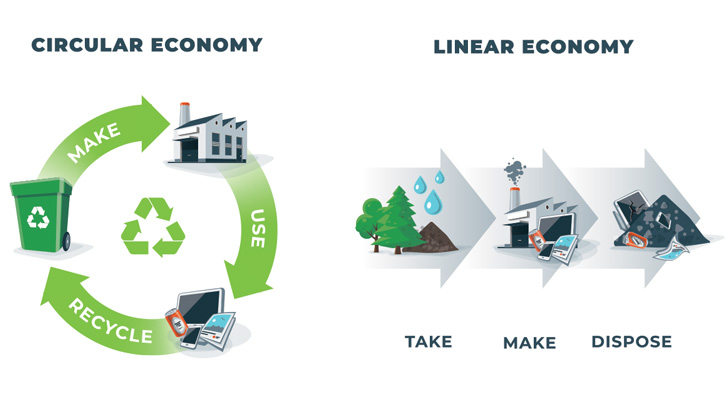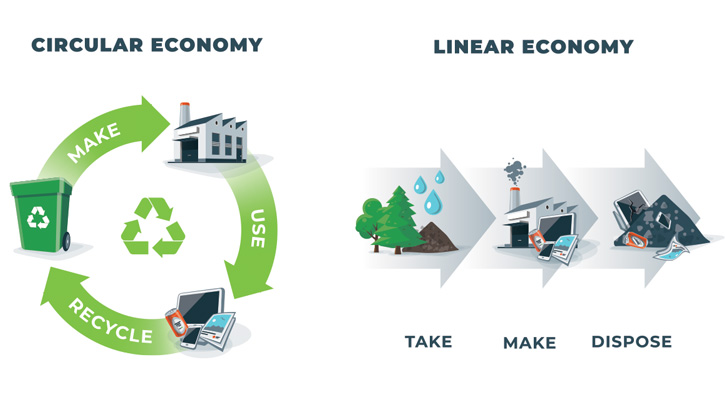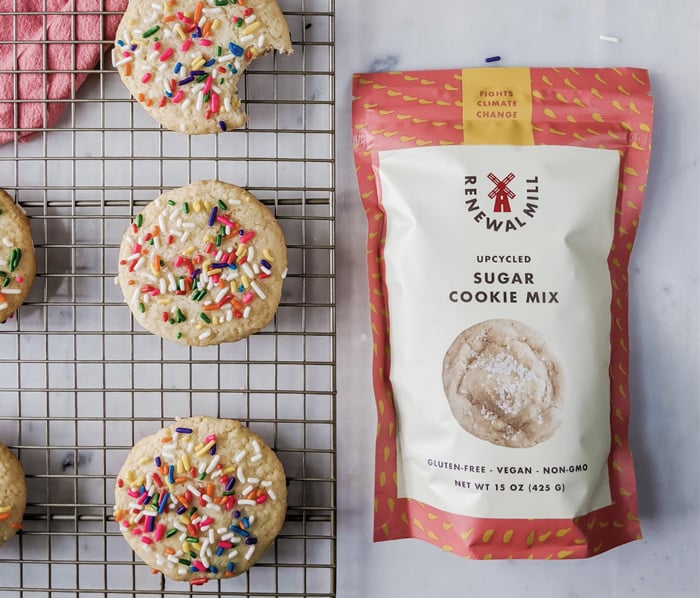Moving Toward a More Circular Food System Via Upcycling
PROCESSING
The industrial revolution led to the birth of a linear economy where the “take-make-dispose” approach formed cheaper and faster production systems to feed a growing population. Following the Great Depression in the 1930s, consumers accentuated this mindset with a focus on maximizing goods and resources accrual, using thrifty strategies to avoid economic hardship, with no thought given to the consequences of unfettered consumption (Hartman 2020). The resulting economic prosperity led to continuous utilization of finite natural resources and reserves, the consequences of which today’s consumption-conscious society is finally beginning to realize.
The circular economy (also circularity) concept, an economic system where waste is eliminated, resources are circulated, and nature is regenerated, was built upon pioneering concepts such as industrial ecology, cradle-to-cradle, and regenerative design, which decouple economic growth from resource use and emissions. Circularity aims to eliminate losses, extend the life cycle of products and processes while retaining function throughout their use phase, and recover value at the end of their use. Smarter manufacturing and product use (e.g., refuse, rethink, reduce), extending the lifespan of the product (e.g., reuse, repair, refurbish), and extracting value from the products at the end of their use (e.g., recycle, recover) were identified in the ranking of circularity options (Potting et al. 2017).
The circular economy framework translates into the food industry as reducing food loss and waste, rethinking new production and consumption channels, extending the shelf life of products, and recovering value from food loss and waste. When combined with today’s consumption-conscious consumers’ increasing demand that brands invest in more sustainable practices as their corporate social responsibility, these circularity concepts can become an attractive playground for businesses.
Upcycled Opportunities
One such circularity concept is upcycling. Upcycled foods represent a circular and culinary food loss and waste diversion opportunity by transforming traditionally discarded agricultural and food waste into added-value products.
To help streamline messaging around upcycling, upcycled food was formally defined in 2020 by the Upcycled Foods Definition Task Force as foods that “use ingredients that otherwise would not have gone to human consumption, are procured and produced using verifiable supply chains, and have a positive impact on the environment.” The task force included members from the National Resources Defense Council, ReFED, World Wildlife Fund, and the Upcycled Food Association.
In its Roadmap to 2030: Reducing U.S. Food Waste by 50%, ReFED identified upcycling for byproducts utilization with a diversion potential of 1.9 million tons of food waste with $2.7 billion net financial benefits. Considering that more than 30% of food is lost and/or wasted, upcycled foods have an annual economic potential value of $700 billion globally, according to statistics from the Ellen MacArthur Foundation (2019). The past few years have witnessed an acceleration of research and development on upcycled product applications and business models to leverage environmental benefits and consumer interest in sustainability.
For example, craft and commercial brewers consider brewers’ spent grain, a byproduct of beer brewing, to be a waste stream that requires disposal. However, it is abundant in protein, fiber, cellulose, and hemicellulose and thus has huge potential in upcycled food formulations with nutritional fortification properties. Examples include protein bar products by ReGrained, plant-based dairy alternatives from spent grains by Take Two Barleymilk, and flour from NETZRO.
To transform brewers’ spent grains from a waste stream to a viable food ingredient, pretreatment and processing modifications based on temperature, pressure, and enzymes are needed because the high protein and insoluble fiber content impacts mechanical properties, physical appearance, and sensory characteristics. Additionally, brewers must adjust their approach from “disposing of a waste stream” to “using Good Manufacturing Practices for food products” when handling brewers’ spent grains if they desire to maximize its value.
Powders and flours from fresh produce, nuts, and seed processing byproducts are also commonly upcycled as ingredients. Renewal Mill’s okara flour is dried soybean pulp obtained from soy milk processing. Previous research has shown that okara flour can be used to replace wheat in bakery products, cereal mixtures, emulsified meat, and more.
Because okara spoils rapidly due to its high moisture content, it must be stabilized through rapid removal of water (drying). For this reason, Renewal Mill has installed process lines for flour production in addition to dedicated in-house R&D and production facilities for creating private label and branded baking mixes and flours.
Another company, Outcast, produces flours from potato, apple, beet, kale, broccoli, and blueberries. Barnana sells flavored snacks made from surplus bananas. Chia Smash offers jams from upcycled fruits, and CaPao produces snacks from cacao fruit pods.
Other upcycled food examples include Nescafé Nativ, a beverage made from coffee fruit husks; Sir Kensington’s Vegan Mayo from aquafaba (the water in which chickpeas have been cooked); AquaBotanical bottled water made from evaporated water from juice production; and Toast Ale beer produced from upcycled bread.
In addition, products intended for non-human outlets are on the rise. For example, JavaCycle Organic utilizes coffee roasting byproducts to manufacture organic fertilizers, and Shameless Pets uses surplus foods to produce organic and grain-free pet treats.
What Consumers Think
Despite this momentum in the upcycled food market, the industry faces challenges. Tangible and measurable environmental contributions, financial returns, and consumer interest must be demonstrated to justify investment.
Formulation challenges combined with supply limitations represent the largest set of hurdles. For example, products traditionally formulated with wheat flours are being replaced with vegetable flours or spent grains, which brings manufacturing challenges resulting from changing physical, compositional, and organoleptic properties.
In addition to processing, consumer acceptance remains a key barrier to success. For some consumers, the idea of consuming “waste” may trigger negative associations. In an online United Kingdom–based survey, 106 participants were presented with two mockup images of biscuits, one made with upcycled sunflower and a second one made using conventional ingredients. Participants were then asked to select their preferred biscuit concept, drivers of their selection, and their familiarity with the term upcycled. Eighty-five percent of the participants had not heard the term upcycling previously but stated that they would consider buying upcycled ingredients (Grasso and Asioli 2020). Neophobia (i.e., new food technology phobia) is also associated with lower willingness to buy upcycled foods among various groups (Coderoni and Perito 2021).
The reasons consumers gave for preferring upcycled products included environmental and health benefits, being able to take a personal role in food waste reduction, and lower price expectations. In contrast to these expectations, upcycled products are generally sold at higher price points due to the added costs of upcycled ingredient recovery and processing. Thus, there is also a concern that upcycled foods inadvertently target urban and high-income settings.
Studies clearly point to the potential impact of labeling and information on the environmental and nutritional benefits of upcycled ingredients and products. Mental stimulation with slogans, sustainability commitments, and graphics can be utilized to increase acceptance rates. For this reason, the Upcycled Food Association launched a third-party certification program, “Upcycled Certified,” to highlight ingredients and brands that utilize surplus food and byproducts with “verifiable supply chains” and that demonstrate environmental benefits to generate awareness, improve messaging, and engender consumer trust. So far, more than 15 companies have certified their products and ingredients.
Implementation Issues
Implementing innovative circular economy models will require the development of new processes, business models, and socio-institutional changes, which can create unintended rebound effects. This will require investment, common motivation, and participation of key food industry stakeholders, including food businesses, policymakers, nongovernmental organizations, consumers, and scientists. Cost-effective operating models are required and are heavily influenced by the low cost of fresh ingredients, such as produce and other agricultural products. Consequently, products with high protein and nutrient density will be the focal point, particularly if brands can effectively communicate the upcycled products’ benefits.
Setting up necessary infrastructure and circular supply chains to produce value-added products can be problematic, in part due to the financial complexities associated with circular business models. Financing circular economy initiatives for new upcycled products or production infrastructure may be challenging, particularly for startup businesses. This is related to the lack of circularity-related performance indices and challenges in risk management due to the generally longer payback horizons associated with circular economy initiatives.
Added processing, formulation, and raw material supply challenges, as well as investment barriers in the upcycled foods market, may present extra obstacles for processors. It is important to communicate efforts clearly and authentically, while avoiding greenwashing in order to prevent consumer confusion and rejection. The environmental benefits and new product opportunities will continue to highlight upcycled foods as one attractive solution to waste.
REFERENCES
Bhatt, S., J. Lee, J. Deutsch, et al. 2018. “From food waste to value-added surplus products (VASP): Consumer acceptance of a novel food product category.” Journal of Consumer Behaviour 17(1): 57–63.
Coderoni, S., and M. A. Perito. 2021. “Approaches for reducing wastes in the agricultural sector. An analysis of Millennials’ willingness to buy food with upcycled ingredients.” Waste Management 126: 283–290. doi.org/10.1016/j.wasman.2021.03.018.
Ellen MacArthur Foundation. 2019. “Cities and circular economy for food.” https://ellenmacarthurfoundation.org/cities-and-circular-economy-for-food.
Grasso, S. and D. Asioli. 2020. “Consumer preferences for upcycled ingredients: A case study with biscuits.” Food Quality and Preference 84: 103951. doi.org/10.1016/j.foodqual.2020.103951.
Hartman Group. 2020. “Value in the Time of COVID-19.” The Hartman Group, Bellevue, Wash. https://www.hartman-group.com/documents/270242195/value-in-the-time-of-covid-19.
Potting, J., M. P. Hekkert, E. Worrell, et al. 2017. “Circular economy: measuring innovation in the product chain.” No. 2544. PBL Publishers.




